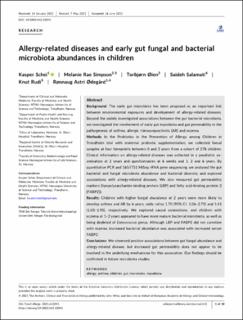| dc.contributor.author | Schei, Kasper | |
| dc.contributor.author | Simpson, Melanie Rae | |
| dc.contributor.author | Øien, Torbjørn | |
| dc.contributor.author | Salamati, Saideh | |
| dc.contributor.author | Rudi, Knut | |
| dc.contributor.author | Ødegård, Rønnaug | |
| dc.date.accessioned | 2021-09-27T07:19:13Z | |
| dc.date.available | 2021-09-27T07:19:13Z | |
| dc.date.created | 2021-08-17T11:01:48Z | |
| dc.date.issued | 2021 | |
| dc.identifier.citation | Clinical and Translational Allergy. 2021, 11 (5), . | en_US |
| dc.identifier.issn | 2045-7022 | |
| dc.identifier.uri | https://hdl.handle.net/11250/2783586 | |
| dc.description.abstract | Background The early gut microbiota has been proposed as an important link between environmental exposures and development of allergy-related diseases. Beyond the widely investigated associations between the gut bacterial microbiota, we investigated the involvement of early gut mycobiota and gut permeability in the pathogenesis of asthma, allergic rhinoconjunctivitis (AR) and eczema. Methods In the Probiotics in the Prevention of Allergy among Children in Trondheim trial with maternal probiotic supplementation, we collected faecal samples at four timepoints between 0 and 2 years from a cohort of 278 children. Clinical information on allergy-related diseases was collected in a paediatric examination at 2 years and questionnaires at 6 weeks and 1, 2 and 6 years. By quantitative PCR and 16S/ITS1 MiSeq rRNA gene sequencing, we analysed the gut bacterial and fungal microbiota abundance and bacterial diversity and explored associations with allergy-related diseases. We also measured gut permeability markers (lipopolysaccharide-binding protein [LBP] and fatty acid-binding protein 2 [FABP2]). Results Children with higher fungal abundance at 2 years were more likely to develop asthma and AR by 6 years, odds ratios 1.70 (95% CI: 1.06–2.75) and 1.41 (1.03–1.93), respectively. We explored causal connections, and children with eczema at 1–2 years appeared to have more mature bacterial microbiota, as well as being depleted of Enterococcus genus. Although LBP and FABP2 did not correlate with eczema, increased bacterial abundance was associated with increased serum FABP2. Conclusions We observed positive associations between gut fungal abundance and allergy-related disease, but increased gut permeability does not appear to be involved in the underlying mechanisms for this association. Our findings should be confirmed in future microbiota studies. | en_US |
| dc.language.iso | eng | en_US |
| dc.publisher | Wiley | en_US |
| dc.rights | Navngivelse 4.0 Internasjonal | * |
| dc.rights.uri | http://creativecommons.org/licenses/by/4.0/deed.no | * |
| dc.title | Allergy-related diseases and early gut fungal and bacterial microbiota abundances in children | en_US |
| dc.type | Journal article | en_US |
| dc.type | Peer reviewed | en_US |
| dc.description.version | publishedVersion | en_US |
| dc.source.pagenumber | 0 | en_US |
| dc.source.volume | 11 | en_US |
| dc.source.journal | Clinical and Translational Allergy | en_US |
| dc.source.issue | 5 | en_US |
| dc.identifier.doi | 10.1002/clt2.12041 | |
| dc.identifier.cristin | 1926569 | |
| cristin.ispublished | true | |
| cristin.fulltext | original | |
| cristin.qualitycode | 1 | |

